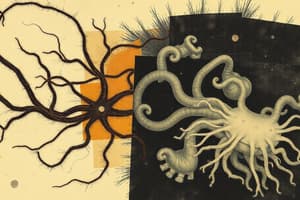Podcast
Questions and Answers
Which of the following statements about Balantidium coli is correct?
Which of the following statements about Balantidium coli is correct?
Which of the following techniques is used for the laboratory diagnosis of Balantidium coli infection?
Which of the following techniques is used for the laboratory diagnosis of Balantidium coli infection?
Which of the following statements about Entamoeba histolytica is correct?
Which of the following statements about Entamoeba histolytica is correct?
Which of the following statements about Entamoeba coli is correct?
Which of the following statements about Entamoeba coli is correct?
Signup and view all the answers
What is the most appropriate diagnostic approach for intestinal amebiasis caused by Entamoeba histolytica?
What is the most appropriate diagnostic approach for intestinal amebiasis caused by Entamoeba histolytica?
Signup and view all the answers
Which stage of Entamoeba histolytica's life cycle is responsible for transmitting the infection?
Which stage of Entamoeba histolytica's life cycle is responsible for transmitting the infection?
Signup and view all the answers
What is the primary symptom of intestinal amebiasis caused by Entamoeba histolytica?
What is the primary symptom of intestinal amebiasis caused by Entamoeba histolytica?
Signup and view all the answers
Which of the following laboratory techniques is considered the method of choice for detecting Entamoeba histolytica in stool samples?
Which of the following laboratory techniques is considered the method of choice for detecting Entamoeba histolytica in stool samples?
Signup and view all the answers
Which of the following statements is NOT true about Entamoeba histolytica?
Which of the following statements is NOT true about Entamoeba histolytica?
Signup and view all the answers
If Entamoeba histolytica is suspected but not recovered from stool samples, which of the following laboratory tests may be utilized?
If Entamoeba histolytica is suspected but not recovered from stool samples, which of the following laboratory tests may be utilized?
Signup and view all the answers
Which of the following is NOT a characteristic of Entamoeba histolytica cysts?
Which of the following is NOT a characteristic of Entamoeba histolytica cysts?
Signup and view all the answers
Which of the following statements is not true about the trophozoite of Entamoeba coli?
Which of the following statements is not true about the trophozoite of Entamoeba coli?
Signup and view all the answers
What is the typical range of nuclei found in Entamoeba coli cysts?
What is the typical range of nuclei found in Entamoeba coli cysts?
Signup and view all the answers
Which of the following structures is not typically found in Entamoeba coli cysts?
Which of the following structures is not typically found in Entamoeba coli cysts?
Signup and view all the answers
What is the primary difference between Entamoeba coli and Entamoeba histolytica in terms of pathogenicity?
What is the primary difference between Entamoeba coli and Entamoeba histolytica in terms of pathogenicity?
Signup and view all the answers
Which diagnostic technique is most reliable for differentiating Entamoeba coli from Entamoeba histolytica?
Which diagnostic technique is most reliable for differentiating Entamoeba coli from Entamoeba histolytica?
Signup and view all the answers
Which of the following statements about the life cycle of Entamoeba coli is correct?
Which of the following statements about the life cycle of Entamoeba coli is correct?
Signup and view all the answers
Study Notes
Balantidium coli
- Chronic infections can cause a tender colon, anemia, cachexia, and alternating diarrhea and constipation.
- Can invade areas other than the intestine, such as the liver, lungs, pleura, mesenteric nodes, and urogenital tract.
- Laboratory diagnosis is done by examining stool specimens for trophozoites and cysts.
- Stools from infected patients with diarrhea are more likely to contain B. coli trophozoites.
- Suspicious formed stools may contain cysts.
- Sigmoidoscopy material can also reveal B. coli organisms.
- Trophzoites can migrate to other organs, such as the liver, causing abscess formation.
- Cyst formation is complete when four nuclei are present.
- Infective cysts are passed out into the environment in human feces and are resistant to physical conditions.
- Survival in a feces contaminated environment for up to a month is common.
Amebiasis (Entamoeba histolytica)
- Infection of the intestine or liver by an ameba, often Entamoeba histolytica.
- Amebae are present in food or water that has had contact with infected feces.
- Symptoms include frequent, loose stools flecked with blood and mucus.
- Amebic abscess often accompanies amebic dysentery.
- Laboratory diagnosis is done by stool examination for E. histolytica trophozoites and cysts.
- Other laboratory tests include serological procedures, such as ELISA, and biopsy of abscess.
Entamoeba coli
-
Trophozoite has blunt pseudopods and exhibits sluggish, nonprogressive motility.
-
The single nucleus is easily recognizable.
-
The nuclear structures are enhanced when the trophozoites are stained.
-
Typical nucleus consists of a large, often irregularly shaped karyosome that is eccentrically located.
-
Vacuoles, often containing bacteria, are commonly seen in the coarsely granulated cytoplasm.
-
No red blood cell inclusions occur.
-
Cyst has a thick cell wall and is round to spherical in shape.
-
One to eight nuclei with typical nuclear features may be seen in unstained and stained preparations.
-
Occasionally, large cysts containing 16 or more nuclei may be present.
-
The granular cytoplasm may contain thin chromatoid bars.
-
The glycogen mass may displace the nuclei present to opposite ends of the cyst.
-
Life cycle is similar to E. histolytica.
Studying That Suits You
Use AI to generate personalized quizzes and flashcards to suit your learning preferences.
Description
Test your knowledge on amoebic infections and the life cycle of the parasite, including migration, encystation, and survival in the environment. Clinical symptoms and other important aspects may also be covered.




